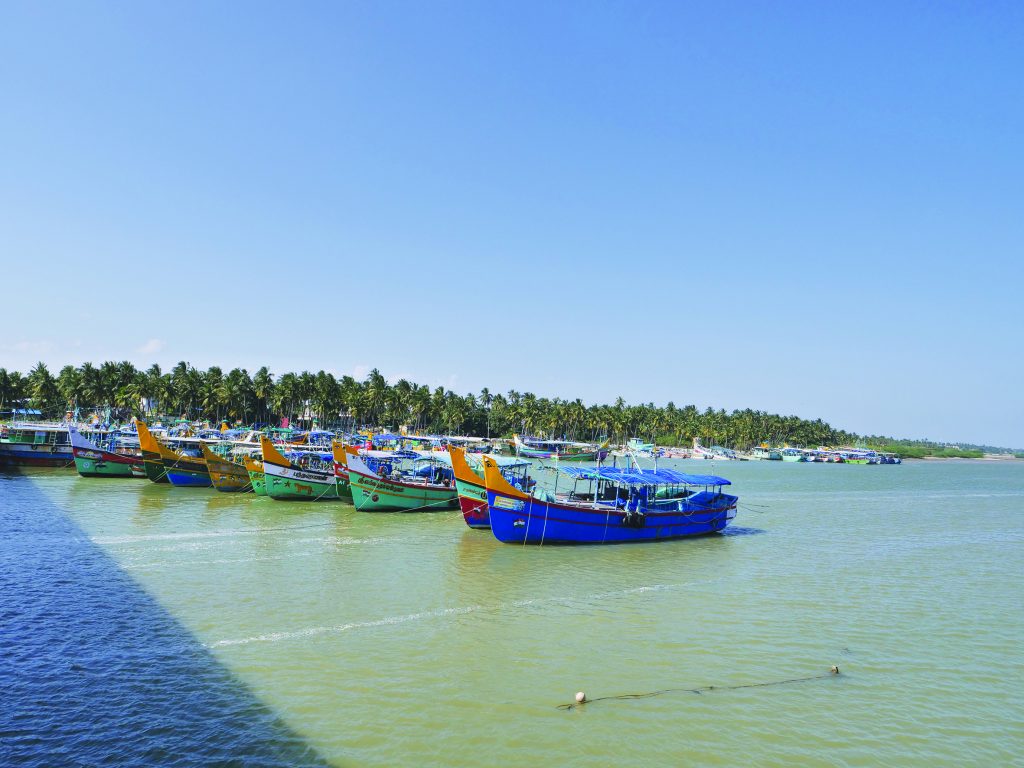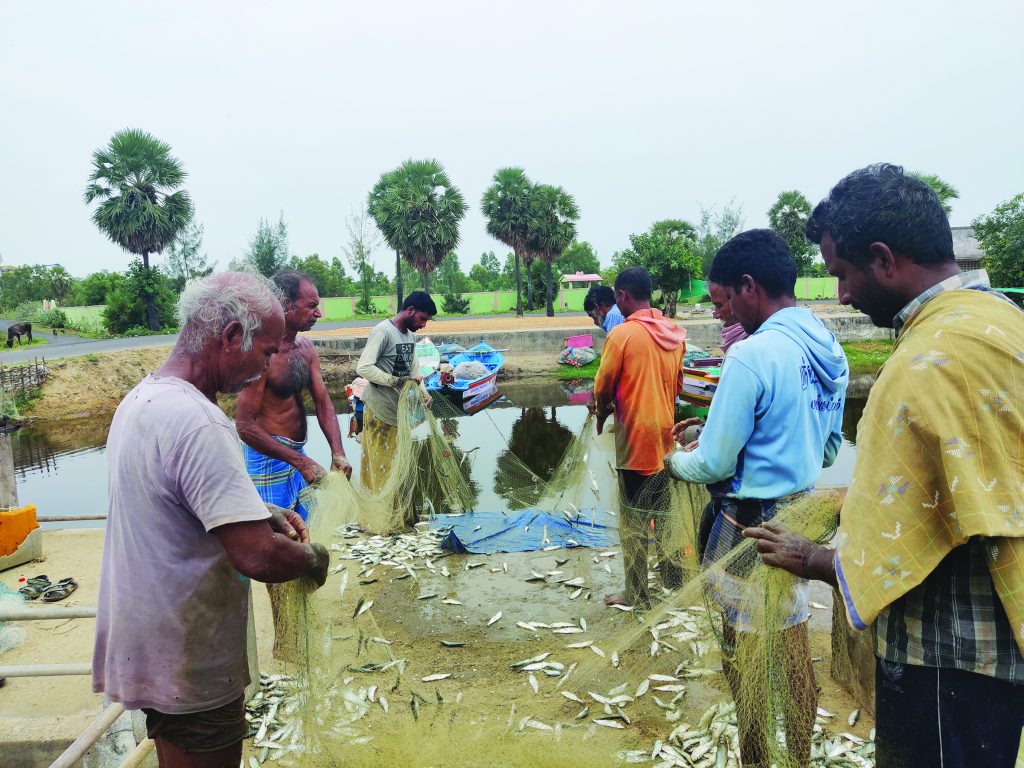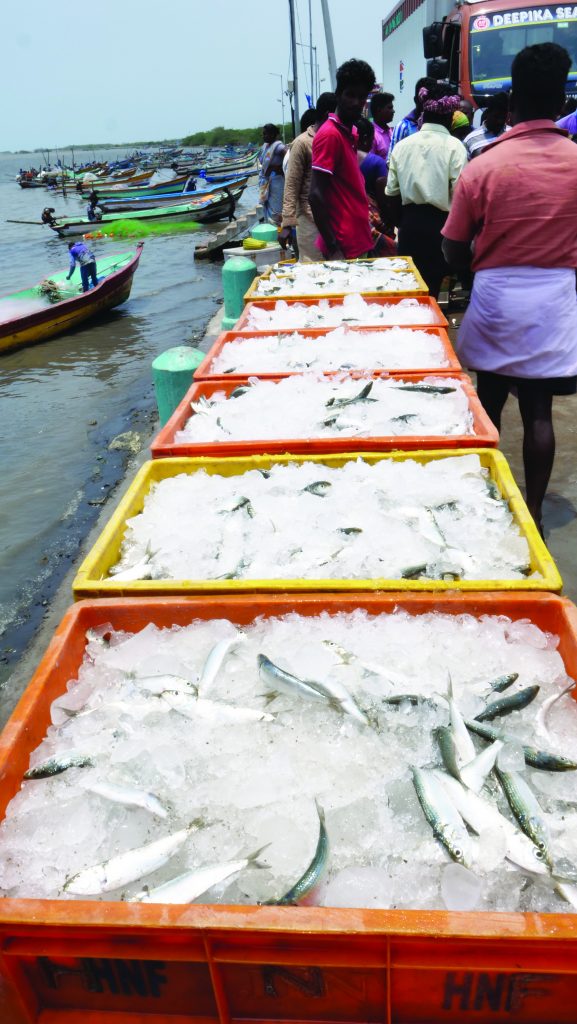Conflicts over fishing gear have again erupted along the Coromandel Coast of India, pointing to the urgent need for effective management
This article is by Dr. Bhagath Singh (bhagath.singh@ifpindia.org), postdoctoral fellow at the French Institute of Pondicherry
In August, 2021 tensions escalated in the state of Tamil Nadu along India’s southeastern coast when an altercation between fishers at sea led one to be hospitalized with serious injuries. A few days later, there was a riot between two fisher hamlets in neighbouring Puducherry (formerly Pondicherry) when ring-seine fishing nets were burnt at sea. The police had to intervene to stop the violence.
The previous month, a section of fishers from two districts in Tamil Nadu blocked a highway to protest against a state government decision to implement a ban on ring seines. Over 1,000 fisherwomen from one of the area’s largest fisher settlements protested in front of the district police headquarters for two days.
Despite the raging pandemic, the coastal villages in Tamil Nadu and Puducherry have repeatedly witnessed violence over the past year. Our team of researchers at the French Institute of Pondicherry have been travelling along this strip of the east coast since 2018 to document the lives of local communities as they cope with socioeconomic and environmental changes.

Disputes over fishing gear are not new in this area, but the reason behind the recent tensions seem to be the oil sardine (sardinella longiceps). An increase in demand for oil sardine, along with administrative failures to implement existing fishing regulations, have resulted in this protracted conflict, causing widespread anxiety and uncertainty in the community. Over the past two years of the COVID-19 pandemic, we have become concerned about conflicts over this widespread fishing gear that has divided fishers in the region. The disputes have escalated since 2018, peaking in 2021. The underlying reasons need to be understood before any help or support can be offered to ease tensions.
Oil sardine is not a preferred delicacy in coastal Tamil Nadu. The pride of place afforded to the kavalai (sardinella gibbosa) does not extend to the mathior the oil sardine. Kavalaicurry is a favourite dish in the kitchen of any class of people; it costs `80-100 per kg (US$1 = `75). The costs of oil sardine can range from `20 to `100 per kg, depending on the market in the neighbouring State of Kerala, where consumer demand for the species is high. Large quantities of small pelagic species going into the fishmeal industry adds to the value of this fish. The Kerala market absorbs about 90 per cent of the oil sardine catch along the Coromandel Coast.
Oil sardine availability has declined along the west coast for reasons that remain unclear; the changes have been attributed to overfishing and environmental factors, including climate change. Along the eastern coast, they are netted in large quantities like never before. Fish landings data, collected by the Central Marine Fisheries Research Institute (CMFRI), register a huge increase in oil sardine landings in Tamil Nadu in 2019, accounting for 43 per cent of the national total. Anandan, a fisherman from Pudukuppam village in Puducherry, said: “Although the fish was always available, large quantities have been landed throughout the year since 2000. With no real value in the local market, we were reluctant to cast our nets into a shoal of oil sardine; half the catch spoils by the time it is removed from the gill-net. But today fishers go out in search of it. No matter the quantity, vehicles queue up on the shore to move them to Kerala.”
… in the past years, disputes over ring seines have started to become more heated and increasingly violent
Over time the craft and gear for sardine fishing have evolved. These days, the largest quantities are caught by ring seines. The gear is the smallest form of purse seines or encircling nets in many parts of the world. The ring seine, first introduced in Kerala, requires a large 55-ft-long fishing vessel (called kannalocally) and seven to 10 small craft. At least 50 workers are required for a ring-seine operation. The large fishing net—handled by a hydraulic winch fitted to the big vessel—encircles the fish shoal. Floaters are attached to the top of the net and a series of rings at the bottom. A long rope threaded through the rings is tightened to close the net at the bottom, forming a purse around the shoal. The catch is loaded on to the small craft. Fishers claim that damage to the catch is minimal, compared to that caught in gill nets. This technology also targets mackerel, seer, trevally and several species of tuna.
Eventually, as the oil sardine migrated from Kerala to the Coromandel Coast, so did the ring seines, as idle boats were sold cheap. Considerable profits catalyzed the spread of ring-seine fishing. When the ring seine was first introduced in northern Tamil Nadu in 2003, rival fishers from a village called Devanampattinam set fire to the nets. Later, this same group of protesting fishers became the leaders of the new technology, accounting for the largest number of ring seines in one village. A leader of this village explained: “We opposed the technology believing fish stocks should be available to all. But we were sued for our protests. When the government favoured this new technology, many people bought ring-seine boats to tap into this lucrative business.”

The ring-seine trips take place in two seasons: from January to mid-April, and from mid-June to November, the onset of the northeast monsoon. At the beginning of each season, the district administration and the police seize some ring-seine boats and trucks with netted fish. Despite the action, operations continue for the next few months without any hindrance. But in the past years, disputes over ring seines have started to become more heated and increasingly violent.
In 2000, the Tamil Nadu government banned the gear with the stated reason of conserving fish stocks. Amendments to the State fisheries law were proposed that year. Fishers who had invested millions fought against the ban. After negotiations, the ban was relaxed for a few more years. Up until 2017, more ring-seine units were purchased cheaply from Kerala. Meanwhile, new steel-hulled ring-seine boats were built locally.
Since kanna boats can operate only with ring seines, fishers invested in a new type of steel boat, combining ring seining and trawling operations. While rare in parts of the northern coast, such boats number more than 100 at three important fishing harbours in Tamil Nadu. Poompuhar, a large settlement with a new fishing port, reveals the scale of this fishery. Here, fishers built the new boats at a cost of `20 mn (US$264,000), shared among 20 to 40 investors. Then the pandemic struck, followeed by successive lockdowns that severely disrupted the fisheries value chain. Since January 2021, the state government has not allowed these newly-built boats to venture into the sea. The investment is earning nothing for the shareholders, many of whom had borrowed heavily. The sudden ban was devastating to many fisher families.
Both the adherents of the ring seine and its opponents—artisanal fishers using selective gear such as gill-nets—have compelling arguments for and against the gear. Although the law appears to favour the artisanal fishers at the moment, in practice the bureaucracy treats both sides in an even-handed manner. It is worthwhile trying to understand the arguments of either side.
Ring seines catch entire shoals of fish, including juveniles. They are also highly effective gear whose benefits accrue to a few boat owners and crew. On the other hand, the divisions between these categories and crew are not always clearly defined: Ring-seine fishers operate with small-scale craft and gear in other seasons. They employ large crew sizes, and the earnings from this gear has improved incomes and standards of living. Its supporters also reject the accusation that the nets indiscriminately catch juveniles.

Neither side is without its arguments. “The whole country is developing, moving towards newer technology. Why should we remain paralysed, limited to artisanal technologies,” asked a young fisher from Thirumullaivasal village in Tamil Nadu. “Should a fisherman live only with one piece of cloth hung around his waist in the future, too?”
Fishing conflicts are common around the world. Fisheries authorities and communities have employed various measures to create a level playing field, ranging from traditional rules such as the Padu system in Pulicat, Tamil Nadu, to legally authorized controls on inputs (craft, gear and other regulations) and the demarcation of fishing zones for artisanal fishers. Tamil Nadu’s Marine Fishing Regulation Act, 1983 was itself a result of the disputes between artisanal fishers and mechanized trawlers. The Act and its Rules demarcated inshore zones reserved for artisanal fishers, protecting their access from mechanized fishing vessels. But the regulations have not been updated to reflect the changes along the coast, and the Fisheries Department has opted for a blanket ban instead of sound management.
As the dispute simmers, ring seiners have demanded not to be singled out; they say all mechanized boats must be stringently regulated. They have emphasized that provisions in the law for minimum mesh sizes and the length of fishing vessels be followed in letter and spirit. Ring-seine fishers have also demanded that large vessels operate only between 5 a.m. and 6 p.m.
To maintain law and order, district administrations restricted all mechanized boats. Explaining the rationale behind the ring seiners’ demands, a fisher leader from Devanampattinam village in Tamil Nadu, said: “This [will] make it clear to the government and the opposition that it is not prudent to ban fishing methods based on a legislation that has not been modified in light of the latest technological developments.” He added: “Since the foreign exchange revenue associated with the oil sardine is low, they can easily block ring seines. They will not do the same to the shrimp industry.” He urged the research community to investigate whether policy has kept pace with environmental and technological developments.
Both fishers and scientists agree that the regulation of ring seine units is imperative. They operate within five nautical miles from the shore, which leads to almost daily conflicts with artisanal fishers. However, the present conflict needs to be understood in the wider context of increasing capacity in the fisheries. In Tamil Nadu, mechanized vessels (mainly trawlers) account for 83 per cent of the catch. “Why don’t government officials intensify their efforts against the negative impacts of trawling and industrial pollution in the coastal belt, instead of concentrating only on ring-seine fishing?”, asked a fisher from Rasapettai village in Tamil Nadu.
Since 2021, several dozen ring-seine boats have lain stranded on the shore—dead investment for marginalized fishing communities. Both sides are victims in this story. As this episode unfolds, it is important to address the shortcomings in existing fisheries-management measures. “It is the fishers’ fault for investing in a banned gear. On the other hand, the Fisheries Department and the district administration [enforced] the law without understanding the issue on the ground,” said SG Rameshbabu, co-ordinator of the Coastal People’s Right to Life Organization.
Increasing demand for seafood, combined with ecological changes and developments in the value chain, will continue to drive innovation and relentless competition in fisheries. The state government of Tamil Nadu should resolve this conflict and ensure a fair distribution of benefits to fishing communities. It can consider strengthening local governance with the participation of traditional institutions and civil society, and updating its regulations to reflect the reality of the fishery. Tamil Nadu’s fishers need a management system guided by the principles of equity and sustainability.
For more
The Troubled Ascent of a Marine Ring Seine Fishery in Tamil Nadu
Clash over use of ring nets, group sets fishing boat on fire
Judgment: M.G. Santhanaraj v. Secretary, Government Of Tamil Nadu And Others
https://www.casemine.com/judgement/in/600125cc9fca1917ab0f9549